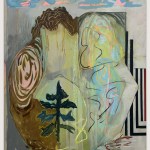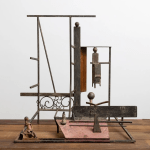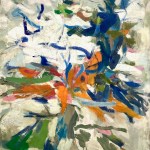
Contributed by Laurie Fendrich / When I walked into the large middle gallery at Matthew Marks, where the stunning work of Miyoko Ito (1918–1983) from the 1970s is concentrated, a person in the gallery turned to me and said, “Give me a coffee machine and a cot and I can spend the rest of my life here.” I completely understood. I first encountered Ito’s work when I was in graduate school at the Art Institute of Chicago. Along with my teachers Ray Yoshida and Richard Loving, Ito joined my roster of painting heroes. The current exhibition includes three small, figurative lithographs, but the thrust of the show is the paintings – painstaking abstractions with allusions. Sixteen, spanning the period 1942 to 1983, the year of her death, are on view. All are modest in scale and, though there are color constants, each has its own particular – and novel – composition.



Ito was born in 1918 in Berkeley, California, to a Japanese-American father and a Japanese mother, a cousin who joined him in the United States in a family-arranged marriage. At the age of 20, Ito went to UC Berkeley, where she focused on English and art. Early in her first year there she met her future husband, Harry Ichiyasu, who later became a Chicago businessman, and with whom she had two children. During her twenties, she came to admire such great modernists as Picasso, Klee, and Bonnard, and later Hans Hofmann and also Giorgio Morandi, with whom she felt a “kinship.” After Berkeley, Ito attended a graduate program at Smith College on scholarship, where she painted watercolors and “struggled” to learn to paint with oils. She then attended (but did not graduate from) the Art Institute of Chicago, also on scholarship. In 1948, she taught herself lithography at Ox-Bow, the summer artist’s residency program in Michigan. Juggling the roles of wife, mother, and painter, Ito persisted in painting in her home-studio, and repeatedly submitted her pictures to juried competitions. “Painting is very much part of my life, like breathing,” she said. “It is a necessity.”

Despite what may seem like an orderly progression, ordeals marked Ito’s life. When she was five, her mother took her and her sister to Japan, where they stayed with relatives for the next five years. Almost immediately, Ito became sick and she remained bedridden for much of the time she was there. Later she described the experience as a “childhood nervous breakdown,” and it deeply and permanently affected her. In 1942, Ito and over 125,000 other Japanese-Americans were forcibly detained in an internment camp. At the camp where she and Ichiyasu were initially sent, she was fortunate enough to be invited to teach watercolor painting under the guidance of Berkeley professor Chiura Obata, who was also confined there. Ito was diagnosed with breast cancer in 1978 and died in 1983 at 65.

One of the most remarkable things about Ito’s paintings is how tenderly they are made. Her technique was very slow – not merely methodical, but meditative – which helps explain why even in the 1970s, when she was well known in Chicago, she painted only around ten paintings a year. She’d often start with a thin, bluish-green underpainting, on top of which she’d draw with charcoal, then erase and draw again. She could do this for days before settling on a design. From a distance, the lines between the shapes in her paintings look as if they’re drawn on the surface, but up close we discover they are the ground peeking through the paint. Her lines are as exquisite as the filaments in a spider’s web, bringing air and light up from underneath the painting to its surface. The resulting sensation is of shapes ever so slightly oscillating.

Ito used short, concise brushstrokes in a mostly horizontal direction. They’re reminiscent of Cézanne’s strokes, only done with determination rather than anxiety. Many of the paintings from the 1960s and 1970s have framing devices, such as a picture within a picture, or an apparent landscape, or a landscape outside a window. Some suggest interiors and embed oblique references to such three-dimensional forms as furniture and mirrors. In the 1970s, Ito’s palette migrated from dark to varied, abundant with pale tans and pinks, light greens and blues, and rich corals, often gradated in value or hue so as to suggest depth. Nothing is too bright, everything is calm.

In his insightful essay in the catalog accompanying Ito’s 1978 retrospective at the Renaissance Society at the University of Chicago, Dennis Adrian, then the city’s preeminent critic, used the word “Japanese” only once, and then only to connect her work’s “spirit and feeling” to historical, formal, and psychological antecedents to rather than to her personal identity. Many today would no doubt find this unforgivable. Yet in the 1970s, save for feminism, notions of identity were muted. Adrian, whose eye was attuned to the formal beauty and mystery of her images, stressed Ito’s essential “Americanness” by arguing that she and a few other Chicago artists expressed “some of the highest levels of American painterly genius.” This is in fact consistent with the way Ito clearly saw herself: as participating in the long tradition of Western art.

Although she was from an older generation than the Chicago Imagists, and her work didn’t fit easily with theirs, Ito was often lumped together with them. She was included in the 1972 Chicago MCA Imagist exhibition, and the next year she exhibited with the Phyllis Kind Gallery, a veritable headquarters of Imagist art. She was also selected for the Whitney Biennial in 1975, and showed at The Phyllis Kind Gallery’s New York outpost the same year. Yet she has remained under-appreciated, which the appearance of her work at Matthew Marks should remedy, however belatedly.


Chicago’s postwar art scene, like New York’s, generally focused on Surrealism, but the link between that movement and Ito’s paintings is tenuous. If her paintings have an otherworldliness, it’s never weird or ominous. When she painted, she never dwelled on the dislocation and discombobulation that marked much of her life, but instead chose to search in paint for something far different. What she found was beauty.

“Miyoko Ito,” Matthew Marks Gallery, 522 W. 22nd Street, New York, NY. Through April 15, 2023.
About the author: Laurie Fendrich is a painter, writer, and professor emerita of fine arts at Hofstra University.























These look amazing! Can’t wait to see them in real life.
I intensely enjoyed this immersive and meditative exhibition of Miyoke Ito’s paintings. Much like Josef Alber’s ‘Homage to the Square’ series, her paint mixtures are so finely orchestrated that they produce an optic oscillation. The keyed down palette is calming and thought provoking at the same time.
Wonderful, informative essay/review of Ito’s paintings.
Thank you!
I wouldn’t comment on this work unless I was in front of it. I think it needs that respect. However, I do very much enjoy the enthusiasm and admiration the author puts into words.
Another well written and informative essay. Thank you Laurie, it’s a pleasure to read this. Like seeing an old friend again.
I really appreciate the way you described the paintings, especially how the technical aspects translate visually and emotionally, as well as the biographical background. It’s a lovely homage as well. Thank you, Laurie. Sure wish I had a cot and lived in New York right now!
Thank you so much for this insightful review Laurie. I was not familiar with her work so your article has driven me to want to see the exhibit.
I am so sorry to miss this show! Thanks, Laurie, for the generous overview.
Beautiful work; beautiful review. Paintings of dignity and serious play.